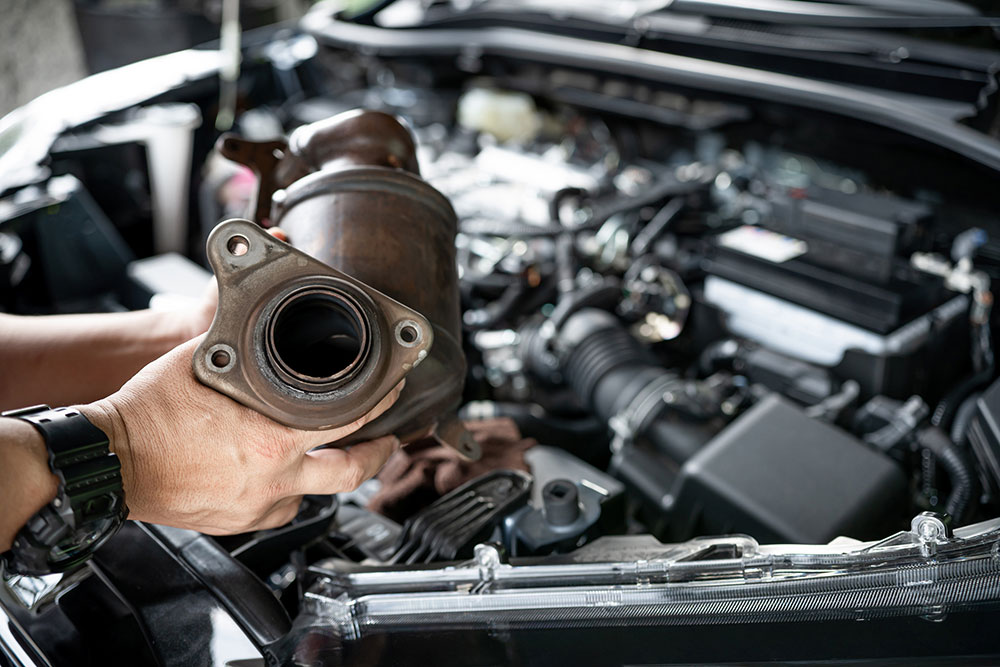Catalytic converters explained

Catalytic converters were introduced in 1986 on petrol engine vehicles in Australia and they are becoming more common on diesel models.
Fitted into the exhaust system relatively close to the engine to ensure they get to their high operating temperature quickly, they generally look like a small muffler with an outer body of stainless steel. A honeycomb ceramic block inside the converter provides a large surface area coated with various noble metals such as platinum, rhodium and palladium.
They act as a catalyst promoting a chemical reaction with the exhaust gases passing through the system. The metals don’t get consumed in the reaction.
Catalytic converters fall into two main types. Two-way or oxidising converters change unburnt/partially burnt fuel (hydrocarbons) into carbon dioxide and water, and carbon monoxide into carbon dioxide.
Three-way converters, now the most common type for petrol engines, also oxidise hydrocarbons and carbon monoxide similar to a two-way converter, but through a reducing process can also deal with harmful oxides of nitrogen. The end products of these reactions are carbon dioxide, water and nitrogen.
Oxidising-type catalytic converters, specifically designed for diesel combustion, are used on diesel engines. They can clean up hydrocarbons, carbon dioxide and a small percentage of the relatively high particulate matter (soot) levels in diesel exhaust.
However, they don’t work well to control oxides of nitrogen. Other control methods such as exhaust gas recirculation (EGR) or selective catalyst reduction (SCR) systems using the injection of a urea-based solution like AdBlue into the exhaust are also required. Catalytic converters typically operate in a temperature range of 375°C to 600°C, so vehicles fitted with them shouldn’t be parked where the converter could be close to dry grass and the like, due to the potential fire risk.
They generally have a long life, but they eventually wear out and require replacement, which can be expensive.
Their demise can be hastened by engine-related problems that increase the level of unburnt hydrocarbons such as misfiring, overly rich fuel mixtures or oil burning from a worn engine.
Such conditions can cause the converter to overheat, melting the internals. Impacts with road hazards such as speed bumps can also easily destroy the internal components.
The converter is part of the vehicle’s emission control system and ensures the vehicle meets the emissions standards it was built to comply with, which is a legal requirement.
Find your nearest RACQ Approved Repairer
Related topics
Things to note
The information in this article has been prepared for general information purposes only and is not intended as legal advice or specific advice to any particular person. Any advice contained in the document is general advice, not intended as legal advice or professional advice and does not take into account any person’s particular circumstances. Before acting on anything based on this advice you should consider its appropriateness to you, having regard to your objectives and needs.
Insurance Products (excluding Travel Insurance) are issued by RACQ Insurance Limited ABN 50 009 704 152 (RACQI) and arranged by its agent, RACQ Distribution Services Pty Ltd (RDS) ABN 35 116 361 650, AFSL 567130 and RDS' authorised representatives (including RACQ Operations Pty Ltd ABN 80 009 663 414, AR No. 234978 (RACQO). Conditions, limits and exclusions apply. RDS and RACQO are in the RACQ group of companies. One of the companies in the RACQ group of companies has a minority shareholding in RACQI.
RDS and RACQO have not taken your personal objectives, circumstances or needs into account when preparing advice regarding insurance products and you will need to consider whether the advice is appropriate for you. Read the Product Disclosure Statement (PDS) and any applicable Supplementary PDS before making a purchase decision on this product. You can also access our Target Market Determinations on this website. RDS receives a commission from RACQI for the policies it arranges. RACQO receives fees paid for services it provides to RDS. Further details about remuneration are available on request prior to purchasing.
Banking and loan products issued by Members Banking Group Limited ABN 83 087 651 054 AFSL/Australian credit licence 241195 trading as RACQ Bank. Terms, conditions, fees, charges and lending policies apply. This is general advice only and may not be right for you. This information does not take your personal objectives, circumstances or needs into account. Read the disclosure documents for your selected product or service, including the Financial Services Guide and the Terms and Conditions, and consider if appropriate for you before deciding.
Except for RACQ Bank, any RACQ entity referred to on this page is not an authorised deposit-taking institution for the purposes of the Banking Act 1959 (Cth). That entity’s obligations do not represent deposits or other liabilities of RACQ Bank. RACQ Bank does not guarantee or otherwise provide assurance in respect of the obligations of that entity, unless noted otherwise.
RACQ Bank subscribes to the Customer Owned Banking Code of Practice which establishes higher standards than the law requires. The Code reflects modern consumer expectations and developments in approaches to issues such as consumer vulnerability, guarantors, and supporting customers through financial hardship. Please read our Customer Owned Banking Code of Practice page for more information.
RACQ Operations Pty Ltd (ABN 80 009 663 414 AR 000234978) and Members Travel Group Pty Ltd (ABN 45 144 538 803 AR 000432492) are acting as an Authorised Representative of the issuer of the insurance, Tokio Marine & Nichido Fire Insurance Co., Ltd. (ABN 80 000 438 291 AFSL 246 548). Any advice set out above is general in nature only, and does not take into account your objectives, financial situation or needs. Before purchasing any travel products, please consider the RACQ Travel Insurance Product Disclosure Statement (PDS) and the Target Market Determinations (TMDs) that apply to these products. Whilst the PDS outlines the Terms and Conditions of these products, the TMDs outline the intended class of customers that comprise the target market for these travel products. This will allow you to consider which products best suit your objectives, financial situation and needs and consider the products appropriateness to your personal circumstances. TMDs also outline matters involving the distribution and the review of these products. The PDS, Supplementary PDS and TMDs for each travel product can be found here.
